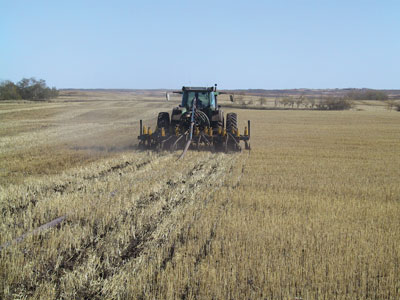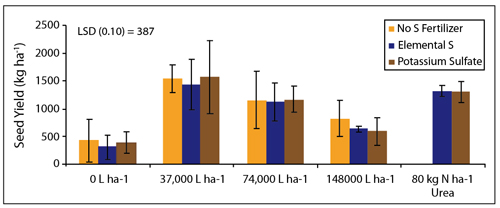
Features
Fertilizer
Seed & Chemical
Supplemental S fertilizer may be required with liquid hog manure fertilization
Some research in the earlier part of this decade had suggested that on sulphur (S) deficient soils, S could be the limiting nutrient for crop growth when liquid swine manure was utilized as fertilizer.
March 3, 2009 By Bruce Barker
Some research in the earlier part of this decade had suggested that on sulphur (S) deficient soils, S could be the limiting nutrient for crop growth when liquid swine manure was utilized as fertilizer. Other research had also found that on S deficient soils, the addition of S helped utilize nitrogen (N) more efficiently, producing higher crop yields. To expand on these findings, Chadrick Carley and Jeff Schoenau at the University of Saskatchewan looked at whether adding supplemental S along with hog manure would enhance the recover of liquid swine manure N.
 |
|
| Variability in swine manure may result in the need for supplemental S fertilizer. Photo Courtesy Of Reduced Tillage Linkages.
|
“Intensive hog operations are capable of generating large amounts of manure. This manure must be dealt with in such a way that is economical and environmentally sound,” says Carley. “The focus of this experiment was to examine possible ways of increasing the yield benefit and plant uptake of manure nitrogen applied to the soil, with the goal of using the nitrogen supplied in the manure more efficiently.”
Carley and Schoenau looked at a trial on a Gray Black Chernozem soil near Melfort, in conjunction with Dr. S.S. Mahli with Agriculture and Agri-Food Canada. Hog manure was applied at a rate of zero, 3300 (applied every year), 6600 (applied every second year) and 13,200 (applied every third year) gallons per acre (37,000L/ha 74,000L/ha and 148,000L/ha), and 71 pounds N per acre (80kg/ha N) urea was also included as a treatment. The application of 3300 gallons per acre of liquid manure supplied approximately 71 to 90 pounds total N per acre, and approximately six to nine pounds total S per acre in the years of application. It should be noted, though, that information on behavior and plant availability of S added in manure is limited.
Supplemental S fertilizers as elemental S or potassium sulfate were applied at 36 pounds S per acre (40kg/ha) every three years starting in 2002 and re-applied in 2005. Canola was grown in 2005 and barley in 2006. All manure fertilizers were injected into the soil with Bourgault coulter openers.
In the canola crop, when urea was applied without S fertilizer, yield was essentially zero. Carley says the lack of seed yield was likely caused by the high S demand of the canola crop while little or no S was supplied by the soil or fertilizer. “This was a classic case of a nitrogen-induced sulphur deficiency. When we added sulphur fertilizer to the urea treatment, yields were significantly higher,” explains Carley.
 |
|
| Figure 1. Canola seed yield at Melfort, Saskatchewan, in 2005, without and with sub-treatments of sulphur fertilizer. |
Looking at the liquid swine manure treatments, no significant differences were observed in canola yield. Even when S fertilizer was applied along with the liquid manure, no differences in yield were seen. “Manure supplied enough sulphur for the canola in the 2005 season. We also found that sulphur fertilizer did not affect the percent of nitrogen recovery,” explains Carley.
Some variability in results
In 2006 barley, S supplied through the liquid swine manure in the 3300 gallons per acre treatment appeared to have sufficient amounts of S to alleviate any S deficiency issues and maximized yield, says Carley. Addition of S fertilizer to the liquid swine manure treatments did not result in increased yield.
In the urea treatment, when 71 pounds N per acre urea was applied in conjunction with S fertilizer, barley yield was significantly higher. This result is similar to results reported by Schoenau, where oats responded strongly to supplemental S fertilizer.
Overall, the supplemental S fertilizers did not have a large effect on seed yield or grain N in manured treatments in the 2005 and 2006 field season. It appears that the liquid swine manure and soil together were able to supply sufficient amounts of available S to maximize yield in the two years of this study.
“The results in 2005 and 2006 are in contrast to our work in previous years where significant responses to supplemental S fertilizer were observed with liquid swine manure. The effects of supplemental S fertilizers on manure N recovery were minimal. Variability in the results may be due to variation in manure nutrient composition and environmental conditions over the seasons,” explains Carley.
The effect of variations in conditions from year-to-year on crop response to S is evident from the results obtained in 2007. In 2007, a significant yield response of barley to the supplemental S fertilizer addition made in 2005 was observed for both the liquid swine manure and urea fertilized treatments. The manure applied in 2007 had a very low S content relative to N.
From a practical standpoint, farmers who routinely apply liquid swine manure to land that is S deficient would
want to first have a nutrient analysis conducted on the manure to ensure there is adequate S in the manure. They would also want to ensure soil tests are utilized, and crop needs are met either through the liquid manure, or in combination with a supplemental S fertilizer. Finally, as always, when in doubt, leave some check strips to assess your own on-farm fertility program.